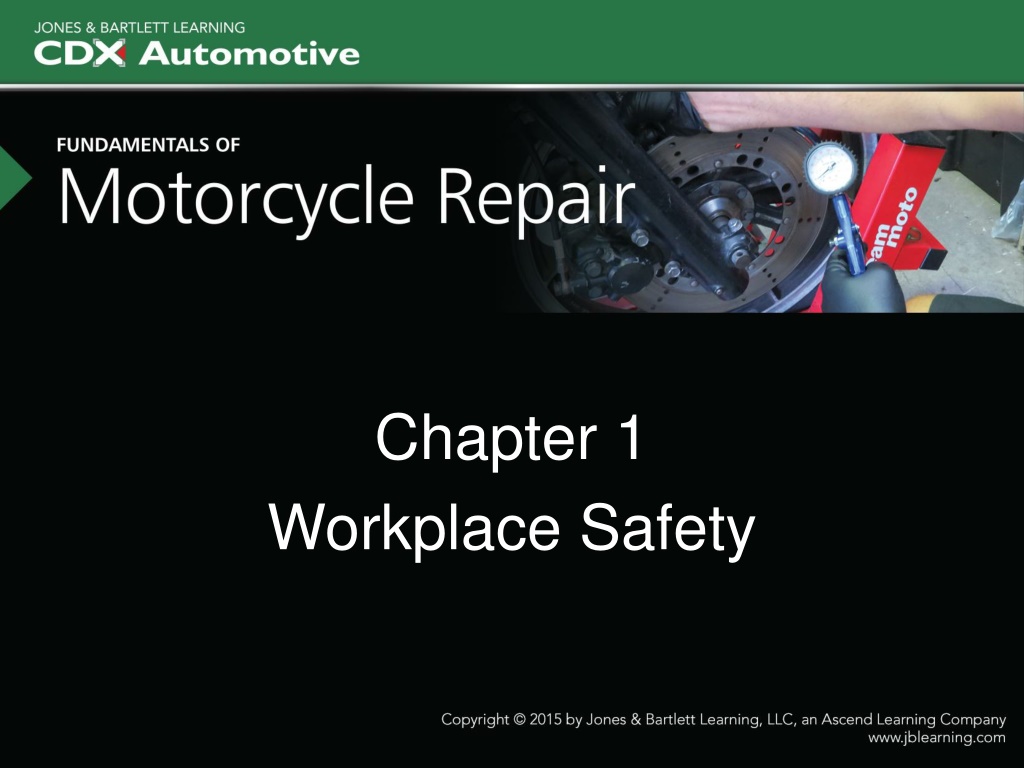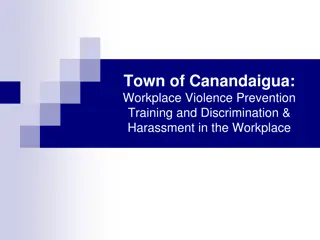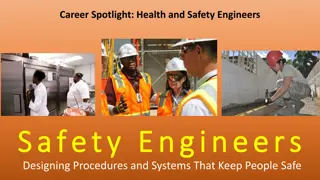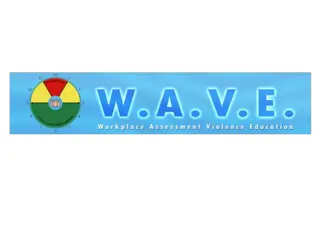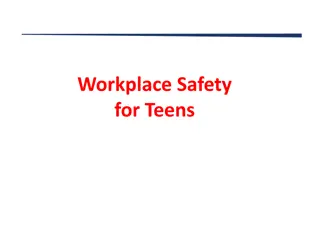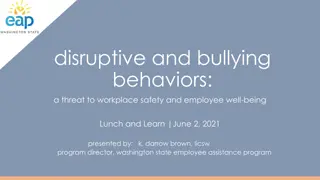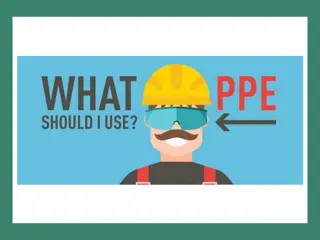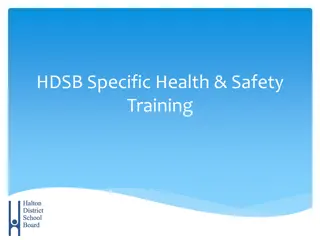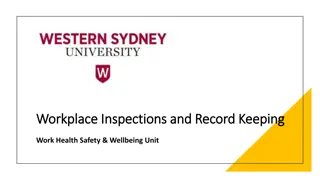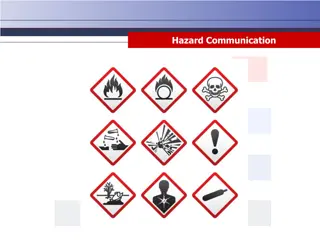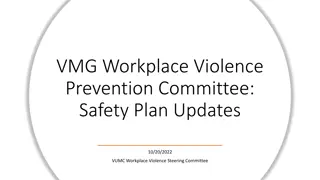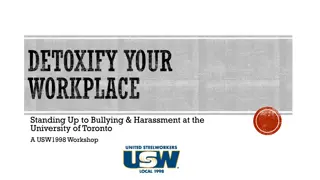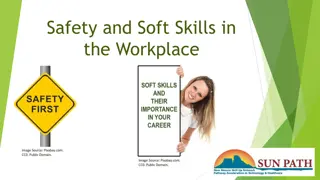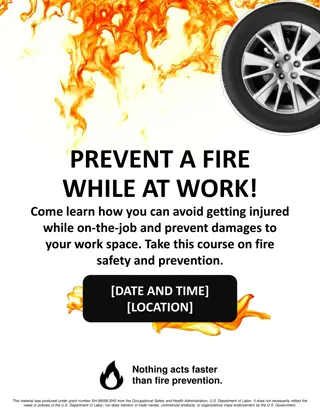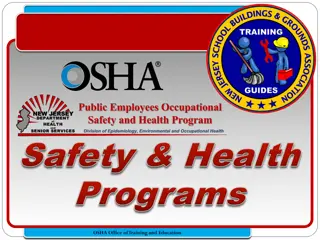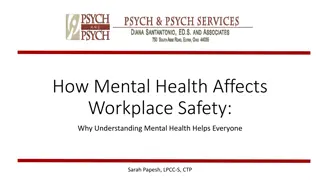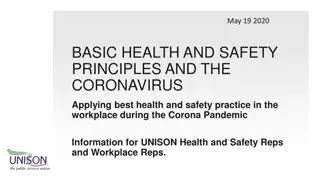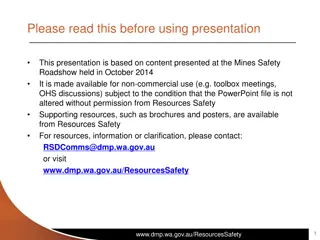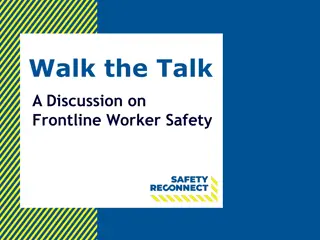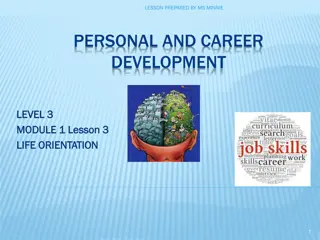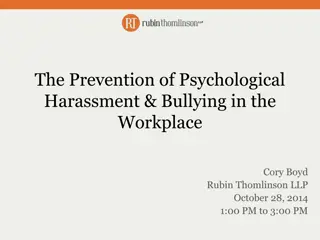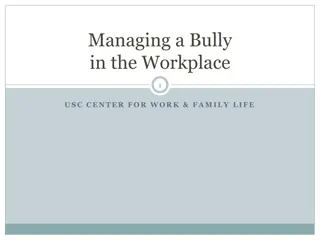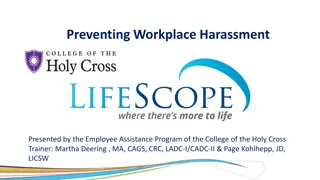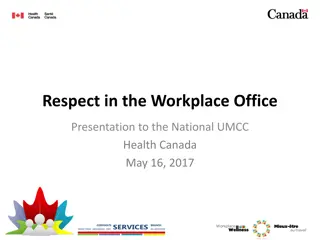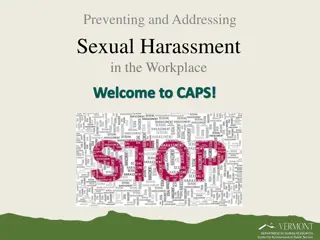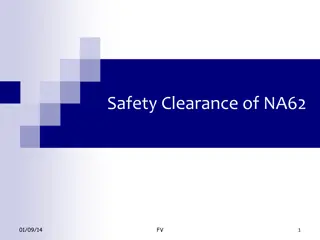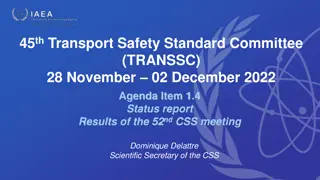Workplace Safety Guidelines and Objectives
This content provides comprehensive information on workplace safety, including general safety rules, evacuation routes, use of safety equipment, personal protective equipment, hazardous materials safety, and first aid principles. It emphasizes the importance of maintaining a safe work environment, identifying hazards, and following safety protocols to prevent accidents and injuries. The objectives cover key aspects like workshop safety inspections, ventilation procedures, and safe handling of hazardous materials. Overall, it aims to promote a culture of safety awareness and responsibility in the workplace.
- Workplace Safety
- Safety Guidelines
- Safety Objectives
- Hazardous Materials
- Personal Protective Equipment
Download Presentation

Please find below an Image/Link to download the presentation.
The content on the website is provided AS IS for your information and personal use only. It may not be sold, licensed, or shared on other websites without obtaining consent from the author. Download presentation by click this link. If you encounter any issues during the download, it is possible that the publisher has removed the file from their server.
E N D
Presentation Transcript
Chapter 1 Workplace Safety
Primary Learning Objectives (1 of 3) Identify general workshop safety rules and procedures. Identify the location of the posted evacuation routes. Identify marked safety areas. Identify the location and the types of fire extinguishers and other fire safety equipment; demonstrate knowledge of the procedures for using fire extinguishers and other fire safety equipment.
Primary Learning Objectives (2 of 3) Identify the location and use of eye wash stations. Locate and demonstrate knowledge of material safety data sheets (MSDS). Comply with the required use of safety glasses, ear protections, gloves, and shoes during lab/workshop activities. Identify and wear appropriate clothing for lab/workshop activities.
Primary Learning Objectives (3 of 3) Secure hair and jewelry for lab/workshop activities. Utilize proper ventilation procedures for working within the lab/workshop area.
Knowledge Objectives Understand a safety overview. Explain standard safety measures. Explain hazardous materials safety. Conduct workshop safety inspections. Describe personal protective equipment. Comply with injury protection practices. Understand first aid principles.
Skills Objectives Identify hazardous environments. Safely clean brake dust.
Introduction (1 of 2) Occupational safety and health is everyone s responsibility. Always: Think about how you are performing workshop tasks Be on the lookout for unsafe equipment and work practices Wear correct personal protective equipment (PPE)
Introduction (2 of 2) Figure 1-1 Personal protective equipment (PPE) refers to items of safety equipment such as safety footwear, gloves, clothing, protective eyewear and hearing protection.
Safety Overview (1 of 4) Don t underestimate the dangers Accidents and injuries can happen at any time and are avoidable Evacuation routes safe way of escaping danger Safe work environment goes a long way toward preventing accidents, injuries, illnesses Figure 1-3 Your workshop may have an evacuation procedure that clearly identifies the evacuation routes.
Safety Overview (2 of 4) (OSHA) Occupational Safety and Health Administration Government agency created to provide national leadership in occupational safety and health (EPA) Environmental Protection Agency Federal government agency that deals with issues related to environmental safety
Safety Overview (3 of 4) Workshop Policies and Procedures Ensure workshop operates according to OSHA and EPA laws and regulations Policy: guiding principle that sets workshop direction Procedure: list of steps required to get the same result each time a task or activity is performed
Safety Overview (4 of 4) Identifying Hazardous Environments Hazard: anything that could hurt you or someone else; impossible to remove all hazards Identify hazards and work to reduce their potential for causing harm See Procedure 1-1: Identifying Hazardous Environments Procedure 1-1 Identifying Hazardous Environments
Standard Safety Measures (1 of 15) Figure 1-4 Signs Three signal words: danger, warning, caution Background color: draws attention to potential hazards A B C Signs. A. Danger is usually indicated by white text on a red background. Signs. B. Warning is usually in black text with an orange background. Signs. C. Caution is usually in black text with a yellow background.
Standard Safety Measures (2 of 15) Signs (cont d) Text: provides additional safety information Pictorial message: allows safety message to be conveyed to people who are illiterate or who do not speak the local language
Standard Safety Measures (3 of 15) Safety Equipment Handrails Machinery guards Painted lines Soundproof rooms Adequate ventilation Gas extraction hoses Doors and gates Temporary barriers
Standard Safety Measures (4 of 15) Air Quality Managing air quality helps protect you from potential harm and protects the environment. Running engines produce dangerous exhaust gases (carbon monoxide and carbon dioxide). Always follow correct safety precautions when running engines indoors or in a confined space. Do not assume an engine fitted with a catalytic converter can be run safely indoors; it cannot.
Standard Safety Measures (5 of 15) Figure 1-5 Extraction hoses should be vented so that the fumes will not be drawn back indoors.
Standard Safety Measures (6 of 15) Electrical Safety Poor electrical safety practices can cause shocks, burns, fires, and explosions Know where electrical panels for your workshop are located In case of emergency, you may need to shut off electricity supply to a work area or workshop Figure 1-6 All electrical switches and fuses should be clearly labeled so that you know which circuits and functions they control.
Standard Safety Measures (7 of 15) Portable Electrical Equipment Extension cord: flexible wiring fitted with ground wire and neoprene- covered cord Tools that operate at 240 volts often sources of shock and burn accidents All electric tools must be equipped with a ground prong or double-insulated Figure 1-7 The extension cord should be neoprene-covered.
Standard Safety Measures (8 of 15) Portable Workshop Lights Protective fitted covers fitted to prevent accidentally breaking If lamp breaks, it can be an electrical hazard Electric droplights common source of shocks Should be designed so that electrical parts never come into contact with outer casing of the device Bulbs in electric droplights vulnerable to impact
Standard Safety Measures (9 of 15) Figure 1-8 All droplights should be properly protected.
Standard Safety Measures (10 of 15) Workshop Layout Efficient and safe with clearly defined working areas and walkways Preventing Fires Danger of gasoline fire always present Fuel vapor extremely easy to ignite Spillage risks Spill kits: absorbent material and barrier dams to contain moderate-sized spills
Standard Safety Measures (11 of 15) Preventing Fires (cont d) Drain fuel only in well- ventilated, level space, preferably outside Always use fuel retriever, preferably removing fuel through filler neck Never weld anywhere near a gas tank or any kind of fuel line Figure 1-9 Always use a fuel retriever; this tool will minimize the chance of sudden large spills occurring.
Standard Safety Measures (12 of 15) Extinguishing Fires Three elements required at same time for fire to occur: fuel, oxygen, heat To extinguish fire, remove at least one element, usually oxygen or heat Never hesitate to call fire department if you cannot extinguish a fire safely
Standard Safety Measures (13 of 15) Fire Classifications Class A: ordinary combustibles such as wood, paper, or cloth Class B: flammable liquids or gaseous fuels Class C: electrical equipment Class D: combustible metals such as sodium, titanium, and magnesium Class K: cooking oil or fat
Standard Safety Measures (14 of 15) Figure 1-10 Traditional labels on fire extinguishers often incorporate a shape as well as a letter.
Standard Safety Measures (15 of 15) Eye Wash Stations and Emergency Showers Eye wash stations: flush eye with clean water or sterile liquid in event foreign liquid or particles in eye When individuals get chemicals in their eyes, they may need assistance in reaching eye wash station (c) Guy Croft SciTech/Alamy Images Figure 1-12 The main types of eye washers include disposable eye wash packs and eye wash stations. Some emergency showers have an eye wash station built in.
Hazardous Materials Safety (1 of 4) Material Safety Data Sheets (MSDS) How hazardous materials should be safely used Any health effects relating to them How to treat a person exposed to them How to deal with them in a fire situation Obtained from the manufacturer
Hazardous Materials Safety (2 of 4) Cleaning Toxic Dust Safely Toxic dust: dust that may contain fine particles that could be harmful to humans or environment Common sources: inside drum brakes and manual transmission bell housings Procedure 1-2 Safely Cleaning Brake Dust
Hazardous Materials Safety (3 of 4) Cleaning Toxic Dust Safely (cont d) If cleaning up after a repair, do not dry sweep dust; use low-pressure wet cleaning method See Procedure 1-2: Safely Cleaning Brake Dust
Hazardous Materials Safety (4 of 4) Used Engine Oil and Fluids Often contain dangerous chemicals and impurities Laws and regulations control how to safely recycle or dispose of in environmentally friendly way Avoid direct contact by always using gloves and other protective clothing Figure 1-14 Used oil and fluids will often contain dangerous chemicals and need to be safely recycled or disposed of in an environmentally friendly way.
Workshop Safety Inspections Identify unsafe equipment, materials, or activities so they can be corrected to prevent accidents or injuries Formal and informal safety inspections should be held regularly
Personal Protective Equipment (1 of 7) Protective Clothing Shirts Pants Shoes Gloves Headgear Hairnets Caps Hard hats Hand Protection Chemical gloves Leather gloves Light-duty gloves General-purpose cloth gloves Barrier cream Cleaning of hands Ear Protection Covers entire outer ear Fitted into ear canal
Personal Protective Equipment (2 of 7) Figure 1-16 Chemical gloves should extend to the middle of your forearm to reduce the risk of chemical burns. Figure 1-15 The proper footwear provides protection against items falling on your feet, chemicals, cuts, abrasions and slips.
Personal Protective Equipment (3 of 7) Figure 1-22 Ear protection comes in two forms: One type covers the entire outer ear, and the other is fitted into the ear canal. Figure 1-18 Light-duty gloves should be used to protect your hands from exposure to greases and oils.
Personal Protective Equipment (4 of 7) Breathing Devices Disposable dust mask Respirator Figure 1-24 To be completely effective, the respirator mask must make a good seal onto your face.
Personal Protective Equipment (5 of 7) Eye Protection Safety glasses Welding helmet Gas welding goggles Full face shield Safety goggles Hair Containment Always remove watches, rings, and jewelry before starting work
Personal Protective Equipment (6 of 7) Figure 1-26 The lens on a welding helmet has heavily tinted glass to reduce the intensity of the light from the welding tip, allowing you to see what you are doing. Figure 1-25 Safety glasses are designed to protect your eyes from direct impact or debris damage.
Personal Protective Equipment (7 of 7) Figure 1-28 It is necessary to use a full face shield when using a grinder, solvents and cleaners, epoxies, and resins or when working on a battery. Figure 1-27 Gas welding goggles can be worn instead of a welding helmet when using or assisting a person using an oxyacetylene welder.
Injury Protection Practices Safe attitude Proper ventilation Correct lifting Housekeeping and orderliness Slip, trip, and fall hazards Figure 1-30 Prevent back injuries when lifting heavy objects by crouching with your legs slightly apart, standing close to the object, and positioning yourself so that the center of gravity is between your feet.
First Aid Principles (1 of 10) First aid: immediate care given to injured or suddenly ill person Three important rules of first aid: Know what you must not do. Know what you must do. If you are not sure what procedures to follow, send for trained medical assistance.
First Aid Principles (2 of 10) Bleeding External: loss of blood from external wound where blood can be seen escaping Internal: loss of blood into body cavity from wound with no obvious sign of blood (c) Jones & Bartlett Learning, Courtesy of MIEMSS Figure 1-32 Apply a gauze pad and direct pressure to the wound.
First Aid Principles (3 of 10) Bleeding (cont d) Make sure you are not exposed to blood Wear latex gloves or an artificial barrier Call 9-1-1 if bleeding cannot be controlled (c) Jones & Bartlett Learning, Courtesy of MIEMSS Figure 1-33 If blood soaks through the bandage, apply additional dressings and pressure bandage.
First Aid Principles (4 of 10) Eye Injuries If object penetrates and becomes embedded in the eye, do not attempt to remove it Call 9-1-1 (c) Jones & Bartlett Learning, Courtesy of MIEMSS Figure 1-34 If an object penetrates and becomes embedded in the eye, stabilize the object with a bulky dressing or clean cloths.
First Aid Principles (5 of 10) Eye Injuries (cont d) If a chemical splashes into eyes, you may be able to flush it out using eye wash station Call 9-1-1 If you can see a loose object, remove it with a moistened sterile gauze or clean cloth Figure 1-36 Flush out the eye to prevent a chemical burn.
First Aid Principles (6 of 10) Fractures Always seek medical care for all fractures Simple: no wound or internal or external bleeding Open: bleeding or protrusion of bone through skin Complicated: penetration of a bone into a bodily structure or vital organ Be aware of onset of shock
First Aid Principles (7 of 10) Sprains, Strains, and Dislocations Sprain: when a joint is forced beyond its natural movement limit Strain: injury caused by the overstretching of muscles and tendons Dislocation: displacement of a joint from its normal position
First Aid Principles (8 of 10) Burns and Scalds Superficial burns (first-degree): reddening of the skin and damage to outer layer of skin only. (c) Jones & Bartlett Learning Figure 1-37 First-degree burn.
First Aid Principles (9 of 10) Burns and Scalds (cont d) Partial-thickness burns (second- degree): blistering and damage to outer layer of skin (c) E.M. Singletary, MD. Used with permission. Figure 1-38 Second-degree burn.
First Aid Principles (10 of 10) Burns and Scalds (cont d) Full-thickness burns (third-degree): white or blackened areas and include damage to all skin layers and underlying structures and tissues Courtesy of AAOS Figure 1-39 Third-degree burn.
